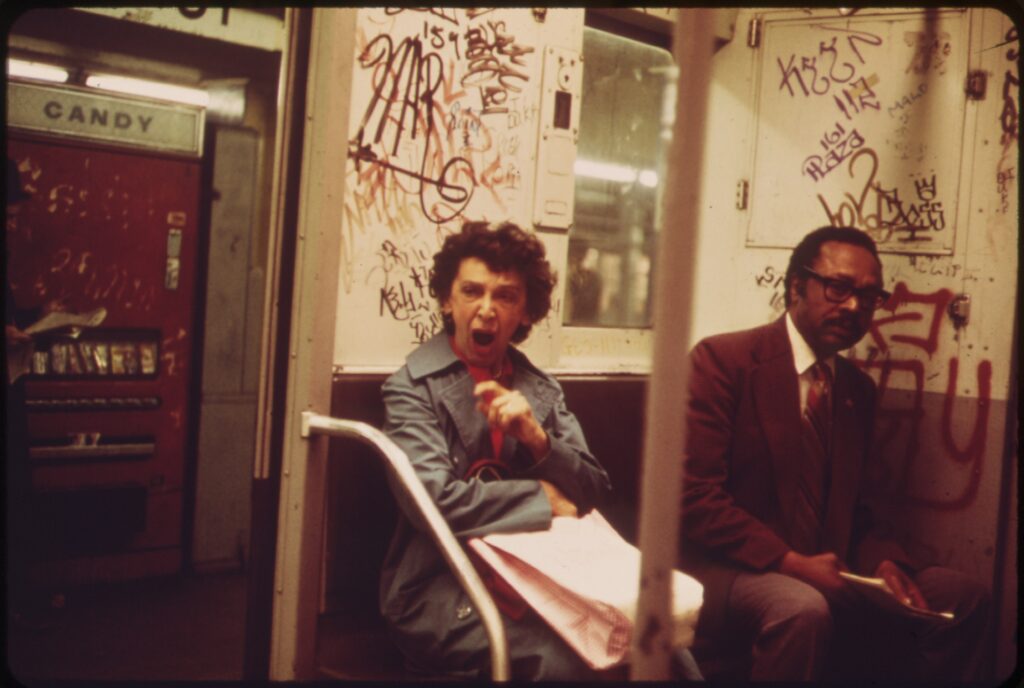
Mid 60s – Early 70s
The early days of modern graffiti, centered in New York and (some say) Philadelphia. Writers start putting up their own tags on walls and subway trains, rather than a gang or neighborhood name. The more your name was up, the more famous you were.
Cornbread vs. Taki-183
- Cornbread was a kid in Philadelphia who started putting his nickname everywhere (even, the story goes, on both sides of an elephant at the zoo). Some people say he was the first writer.
- TAKI183 was a kid in New York who started bombing, putting his name everywhere and especially on the subway system. Some people say he was the first writer.
As more and more tags appear, New York City begins a ‘war on graffiti’ in 1972.
If a “History of Graffiti” were to exist, it would be more of an archeology than a history.
After all, a tag leaves a physical trace in paint; that is what a tag is. Which is why we can still talk about Roman Graffiti: after thousands of years, the in-jokes and the drawings of dicks remain. Even if a tagged wall has been demolished, blown up, and no photograph was ever taken, it may still be remembered, consciously or not, by people who passed it by.
Both luck and reputation shape the “History” of early graffiti writing in New York City. Some writers get talked about more than they should, others don’t get talked about at all. You talk to ten writers who were there, you get ten different histories. Three or four will claim to have invented wildstyle.
History is about words, it lives on first-hand accounts, on documents and records. But the pioneers of graffiti didn’t leave behind diaries or journals, the documentation is selective and there isn’t much of it. They did their writing on walls.
Archeology is about objects, the physical traces we leave behind us. It is how we will know about the graffiti the ancient Romans left behind and, if there are people in the far future, archaeology is how they will know about our graffiti.
Mid 70s
The graffiti subculture keeps growing, especially in New York. Every subway car has tags, inside and out.
Tags and Throw-ups vs. Pieces
- New styles of lettering, like bubble and wildstyle, began to appear, and so did the distinction between tags, throw-ups, and master’peices.’
- Some writers dismissed this new style, such as Junior-161, who in 1974 said “That’s just fanciness. How’re you going to get your name around doing all that fancy stuff?”
The ‘top-to-bottom,’ with one piece covering the entirety of a train car, becomes the supreme artistic accomplishment in this era.
Late 70s – Early 80s
The graffiti movement continues, with more styles emerging and the quality of pieces on trains reaching higher levels. The increasing importance of graffiti in the art scene leads to the emergence of legal walls. Some writers start to show their work at galleries.
Going gallery vs. Staying on the street
- In one of the first artistic presentations of graffiti, Fab 5 Freddy and Lee were invited to exhibit in Italy (1979). Jean-Michel Basqiat, whose tag with Al Diaz was SAMO©, emerged soon after.
- Some outsiders believed statements like: “Illegal stuff, that’s really always where the real scene is,” and “Graffiti is vandalism.”
Mid 80s
In 1984, the New York subway system figured out how to quickly and effectively clean its cars, leading to the disappearance of subway graffiti. Some artists focus on gallery and legal work, while other writers focus on bombing the streets.
As the practice of writing on trains fades away, the documentation of graffiti spreads more widely. Notable releases include the documentary Style Wars (1983), Martha Cooper’s book Subway Art (1984), and zine IGTimes (1984 – 1994).
The Time Since
Depends who you ask…
